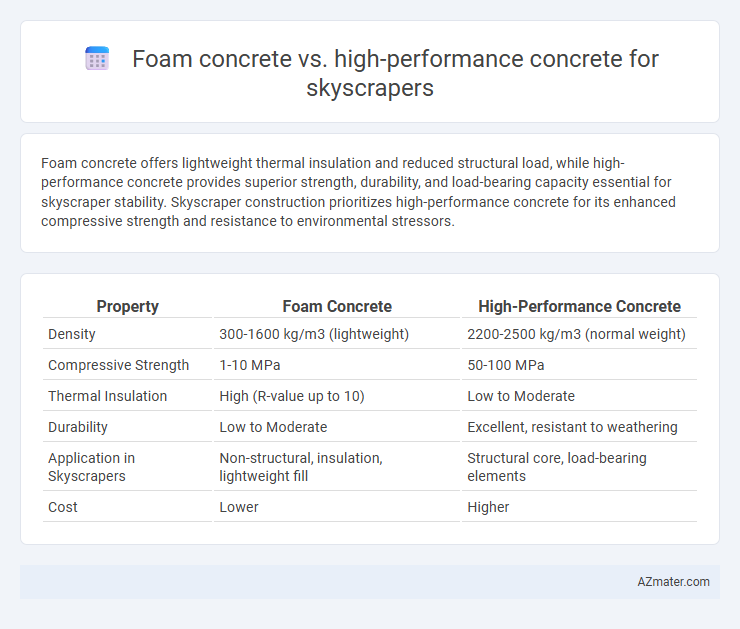Foam concrete offers lightweight thermal insulation and reduced structural load, while high-performance concrete provides superior strength, durability, and load-bearing capacity essential for skyscraper stability. Skyscraper construction prioritizes high-performance concrete for its enhanced compressive strength and resistance to environmental stressors.
Table of Comparison
| Property | Foam Concrete | High-Performance Concrete |
|---|---|---|
| Density | 300-1600 kg/m3 (lightweight) | 2200-2500 kg/m3 (normal weight) |
| Compressive Strength | 1-10 MPa | 50-100 MPa |
| Thermal Insulation | High (R-value up to 10) | Low to Moderate |
| Durability | Low to Moderate | Excellent, resistant to weathering |
| Application in Skyscrapers | Non-structural, insulation, lightweight fill | Structural core, load-bearing elements |
| Cost | Lower | Higher |
Overview: Foam Concrete vs High-Performance Concrete
Foam concrete offers lightweight properties and excellent thermal insulation, making it suitable for non-load-bearing applications in skyscrapers, while high-performance concrete (HPC) provides superior strength, durability, and enhanced load-bearing capacity critical for structural components. Foam concrete's lower density reduces the overall building weight and foundation costs, whereas HPC's advanced composition delivers enhanced resistance to environmental stress and longer service life in high-rise structures. Selecting between foam concrete and HPC depends on balancing insulation needs with structural performance requirements specific to skyscraper construction.
Material Composition and Key Properties
Foam concrete is composed of cement, water, and a foaming agent, resulting in low density and thermal insulation, making it suitable for non-structural applications in skyscrapers. High-performance concrete (HPC) incorporates advanced admixtures like silica fume and superplasticizers, achieving high compressive strength, durability, and reduced permeability crucial for load-bearing elements in tall buildings. While foam concrete emphasizes lightweight and energy efficiency, HPC prioritizes mechanical strength and longevity under extreme structural demands.
Structural Strength and Load-Bearing Capacity
High-performance concrete (HPC) exhibits superior structural strength and enhanced load-bearing capacity compared to foam concrete, making it more suitable for skyscraper construction where durability and resilience against heavy vertical loads are critical. While foam concrete offers advantages like lightweight properties and thermal insulation, its lower compressive strength limits its use primarily to non-load-bearing applications or as a supplementary material in high-rise buildings. Structural engineers prioritize HPC in skyscraper frameworks to ensure longevity, safety, and optimal performance under dynamic and seismic loads.
Weight and Density Comparison
Foam concrete typically has a density range of 400 to 1600 kg/m3, making it significantly lighter than high-performance concrete, which usually ranges from 2400 to 2500 kg/m3. The reduced weight of foam concrete provides advantages in skyscraper construction by lowering the load on the foundation and enabling faster installation. Conversely, high-performance concrete offers superior strength and durability but adds substantial weight, impacting the overall structural design and foundation requirements.
Thermal and Acoustic Insulation Performance
Foam concrete offers superior thermal insulation with its low density and high air content, significantly reducing heat transfer in skyscrapers compared to high-performance concrete, which prioritizes compressive strength over insulation. Acoustic insulation in foam concrete is enhanced due to its porous structure, effectively dampening sound transmission, whereas high-performance concrete, being denser, provides higher mass-related sound blocking but less sound absorption. For skyscraper applications, foam concrete is preferred where energy efficiency and occupant comfort from noise are critical, while high-performance concrete suits structural demands needing enhanced durability and load-bearing capacity.
Durability and Lifespan in Skyscraper Applications
Foam concrete offers excellent lightweight properties but generally falls short in durability and lifespan when compared to high-performance concrete (HPC), which is engineered for superior strength, resistance to environmental stressors, and long-term structural integrity essential for skyscrapers. HPC incorporates advanced admixtures and optimized mix designs that enhance its resistance to corrosion, freeze-thaw cycles, and chemical attacks, ensuring a lifespan that often exceeds 75 years in demanding high-rise applications. The enhanced durability and extended service life of HPC make it the preferred choice for skyscraper construction where long-term performance and safety are critical.
Construction Process and Workability
Foam concrete offers exceptional workability due to its lightweight and flowable nature, enabling easier pumping and placement in complex skyscraper formworks, reducing labor intensity and construction time. High-performance concrete (HPC), characterized by its high strength and durability, tends to require more precise mixing and curing processes, demanding skilled labor and controlled environments to achieve optimal results in skyscraper applications. The construction process with foam concrete benefits from its rapid setting and thermal insulation properties, while HPC demands meticulous batching, vibration, and curing to ensure structural integrity and longevity at high-rise scales.
Cost Analysis: Material and Installation
Foam concrete offers significant cost savings in material and installation compared to high-performance concrete, primarily due to its lightweight nature and reduced cement content. High-performance concrete requires expensive admixtures and precise curing processes, increasing both material expenses and labor costs. While foam concrete lowers structural loads and foundation costs, high-performance concrete delivers superior strength and durability at a premium price point suitable for critical load-bearing components in skyscrapers.
Sustainability and Environmental Impact
Foam concrete offers superior sustainability benefits for skyscraper construction due to its lightweight composition, which significantly reduces the dead load and decreases structural steel requirements, leading to lower embodied carbon emissions. High-performance concrete (HPC), while offering enhanced strength and durability, often involves higher cement content, contributing to increased CO2 emissions associated with cement production. The use of foam concrete can improve thermal insulation and reduce energy consumption over the building lifecycle, making it an environmentally favorable choice compared to traditional HPC in sustainable skyscraper engineering.
Best Practices: Choosing the Right Concrete for Skyscrapers
Foam concrete offers lightweight properties and excellent thermal insulation, making it ideal for non-structural components and reducing overall building weight in skyscraper construction. High-performance concrete (HPC) provides superior strength, durability, and enhanced load-bearing capacity, essential for the core structural elements and tall, slender designs. Best practices emphasize using HPC for critical load-bearing frameworks while leveraging foam concrete for insulation and weight reduction, ensuring optimal structural integrity and energy efficiency in skyscrapers.

Infographic: Foam concrete vs High-performance concrete for Skyscraper
 azmater.com
azmater.com